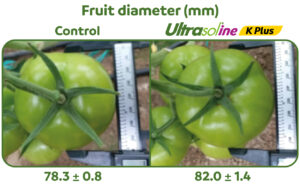A series of experiments was conducted in Hungary, Spain, Italy and Israel to evaluate the specific contribution of potassium nitrate to yields and quality parameters of processing tomatoes (Lycopersicon esculentum Mill.).
In Hungary, 92 kg ha-1 of side-dressed K2O applied as potassium nitrate (NOP) was proven superior to potassium chloride (MOP) and to potassium sulfate (SOP) as based on total marketable yield (12,8% over control) (Figure 1), mean fruit weight (3,9% over control) and dry matter content (26,1% over control).
In Spain, side dressing with 92 kg ha-1 of K2O, applied as potassium nitrate, improved plant performance by increasing mean plant yield, °Brix and mean fruit weight by 25%, 5,13%, and 5,15%, respectively. Total yield was increased from 59 to 70 t ha-1 (Figure 2). Consequently, the added income to the grower far exceeded his marginal costs for fertilizers.
In Italy, application of 260 kg ha-1 of K2O was most effective (total yield =187 t ha-1) when 70% of this dosage was applied as potassium nitrate via fertigation during the growing season. This treatment generated higher yields compared to application of the entire N-P-K or the entire P-K rates as a single pre-transplant application (156 t ha-1, or 177 t ha-1, respectively) (Figure 2). Additional benefits of the fertigation treatment were a higher proportion of class I fruit and an increased mean fruit weight; however, °Brix was somewhat reduced.
In Israel, the authors found a convex parabolic response of lycopene yield and concentration in tomatoes of 4 different cultivars to the K concentration in the nutrient solution. Lycopene concentration of 207 mg kg-1 in fruit fresh matter was obtained when K concentration in the nutrient solution was 8 meq L-1. Highest lycopene concentrations were observed when fruit dry matter was 4,5% or higher. Nitrate was found to be the best form of nitrogen for maximum lycopene concentration in the fresh fruit (Figure 2).
 Figure 1. The effect of different K-sources on the total tomato yield in Hungary.
Figure 1. The effect of different K-sources on the total tomato yield in Hungary.

Figure 2. The yield increase (%) by using potassium nitrate in processing tomato. In Italy only base dressing is compared with 70% KNO3 as fertigation. For Israel the benefits of only nitrate is compared to nitrate/ammonium combination.



